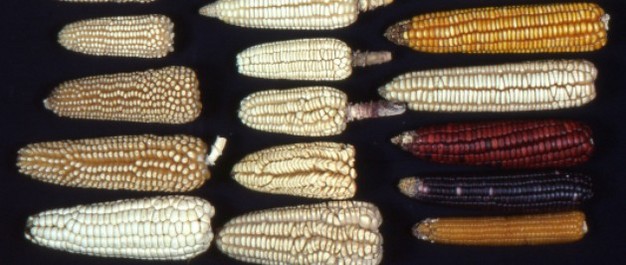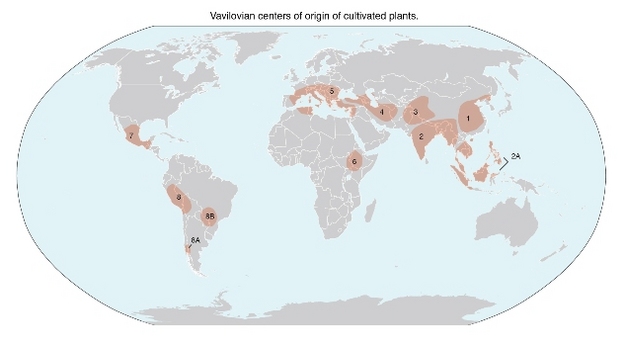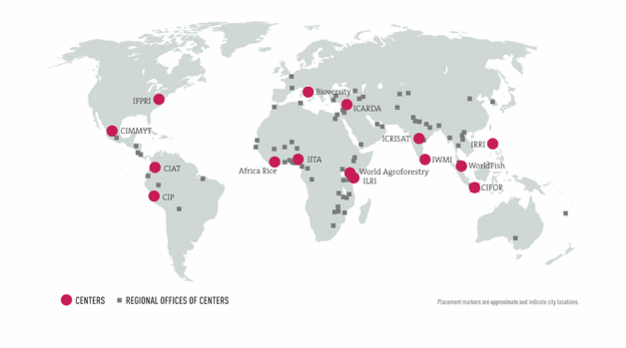« Prev Next »

Colonization of the "New World" initiated the interchange of cultivated plants between the Americas, Africa, Asia and Europe. Plants and animals that made the passage between hemispheres have created an interdependency that reckons origin, value and ownership few can accurately place a dollar value on. Yet even cursory examination of the value of wheat to China, soybeans to the United States, natural rubber to Indonesia or maize to African nations calls attention to the importance of populations that provide genetic variation for continued crop improvement. The reservoir of genetic diversity represented by traditional varieties of maize, wheat and soybeans and their wild ancestors in their Latin American and Asian countries of origin is priceless. Areas yet harboring these varieties/species today are witnessing their extinction as economic development programs promote displacement of older technologies in a process known as genetic erosion. The collection and storage of seeds of landraces in genebanks has been the conservation method of choice to avert extinction of cultivated plant populations. This practice maintains the landrace populations in a static condition that, depending on the original collection, may suffer from genetic bottlenecks or adaptation to artificial environments. Species with specific pollinators are particularly susceptible. Conservation of dynamic populations in situ as an alternative to ex situ, poses a significant challenge because interests of traditional farmers might not coincide with national and international agencies that promote industrial agriculture. In situ conservation averts the challenge posed in ex situ by permitting cultivated plants to evolve with changing environments.
Why conserve cultivated plants?
Today, as the cost of food increases, conservation of this global patrimony of cultivated plant germplasm is a task requiring vigilance. Historically agriculture has encountered numerous ecological challenges (pests, pathogens, adaptation, culinary preferences, and increasing demand) that are often overcome by resorting to genes found in landraces, breeders stocks and wild relatives. Examples abound. The corn blight (Bipolaris maydis) in the southern US during the 1970s, the current wheat rust epidemics in Africa and Asia, as well as the Xanthomonas wilt that threatens extinction of the Cavendish variety of bananas all require novel sources of germplasm from farmers who continue to propagate traditional varieties of crops (Figure 1). Insuring future agricultural yields will feed the world's expanding populations relies on the conservation of cultivated plants. The predators and parasites of crop plants evolve to take advantage of the ever increasing populations of their prey and continual inputs of resistance or immunities are necessary from genetically diverse populations of farmer's varieties, land races, breeders stocks and elite lines of multinational industrial life science corporations. The escalating arms races pitting parasite (rust fungus, lepidopteran larvae) against prey (cultivated plant) is guaranteed.

Growth of the human population and disparate patterns of resource consumption among nations provoke extinction (Ehrlich and Goulder 2007). For example, the US consumes more oil per day than twice that used by China (more than five times as much as India) and much more of the illicit drugs produced in the world. Modernizing rice agriculture to feed greater numbers in China and India displaces indigenous landraces and endemic cultivars. Production of avocados, palm kernel oil and natural rubber (FAO 2011) in Indonesia or Malaysia displaces indigenous populations of rattan, rambutan and rice. Marijuana cultivation in Latin American displaces endemic maize landraces and cultivars. Most of these displacements are due to increased national food security demands and the disparate consumption patterns by the US and Europe. Loss of cultivated plant diversity — so-called genetic erosion — results from these forces operating in culturally traditional agricultural habitats. While displacement of traditional crop varieties by modern varieties can be expected as technological innovation, extinction of cultivated crop plants is a conundrum that we have and should not take lightly.
How is cultivated crop plant conservation accomplished?
In 1992, the United Nations convention on biological diversity (CBD) embraced the imminent sixth mass extinction. Signatory countries assumed the responsibility for complete inventory of the biodiversity within their borders including domesticated species of plants and animals that sustain agricultural needs (UNEP 2011). Signatory states made efforts to comply by conducting thorough inventories of biological diversity including cultigens, their wild relatives and systematic collection of cultivars throughout their sovereign lands (e.g., CONABIO in Mexico; (Brush 2007))
During the last 12,000 years, humans changed their subsistence systems from hunting and gathering to food production. Efforts to produce food yielded domesticated species, crop plants and animals that depend on humans for their survival and perpetuation. These crop plants provide the majority of the current human populations' nutritional needs. Artificial selection and genetic drift left indelible marks on cultivated and domesticated plant populations: reduced genetic diversity resulted from genetic bottlenecks and selection for perceptual distinctiveness. In spite of rapid and widespread dispersal from the Vavilovian centers (Figure 2) where initial domestication took place, perhaps as much as 7 percent of genetic loci in some cultigens show the effects of genetic bottlenecks. Breeding techniques of the last ten millennia also led to the diversification of geographically populations adapted to local environmental and culinary preferences, landraces, traditional varieties or cultivars maintained by subsistence agriculturalists. Recognized by Darwin, and DeCandolle before him, these landraces evolved regional distinctiveness whose genetic distinctiveness is attributed to dispersal and local adaptation (Vigouroux et al. 2008). Much local genetic variation in landraces remains unexplained, however. Understanding will require considerably greater attention to local cultural practices to determine whether indigenous practices such as kin-based heirloom seed inheritance or market forces act to create and maintain local genetic diversity (Perales et al. 2005).

Human population growth and bouts of famine during the last century brought great impetus to increase agricultural production. Third World countries beginning in the 1930's sought support from foundations with interests in improving human wellbeing. The Rockefeller Foundation supported decades of research, extension and education to improve agricultural production. Improved varieties distributed to peasants since the 1940's were developed from breeding populations derived from the indigenous varieties themselves. Early on, realization of the importance of the indigenous landraces (Stakman et al. 1967) led to the creation of the first ex situ germplasm banks. Under this program, only marginal agricultural lands would inevitably conserve these landraces in situ as development programs fostered distribution of improved varieties. Displacement continues as governments and NGO's foment adoption of improved varieties distributed by public programs (Williams 1988);(Frankel and Soule 1981) and industry. Displacement by industrial agricultural varieties has prompted concern about the impact of gene flow between homogeneous transgenic varieties, landraces and wild relatives of crops (Mercer and Wainwright 2008, Piñero-Nelson et al. 2009) .
Conservation of cultivated plant germplasm can be accomplished by ex situ and in situ means. The ex situ strategy has evolved over the years from the initial banking of collections by the renowned Russian plant collector R. Regel and explorer N. Vavilov around the turn of the last century(VIR ). The Rockefeller Foundation's involvement in Latin American and later in India mitigated impacts of displacement by improved variety distribution through creation of germplasm banks in Mexico (Centro de Mejoramiento de Maiz y Trigo; CIMMYT) and Colombia (Centro Internacional de Agricultura Tropical; CIAT). Today these collaborate with more than 100 similar national institutions (Figure 3). Today ex situ conservation embraces many of the challenges and goals Regel and Vavilov realized: namely, conserve the broad genetic base of agricultural crops and increase sustainable agricultural production all while quantifying the sources of genetic diversity in ex situ collections, and documenting the genes responsible for specific phenotypes using molecular markers (Ortiz et al. 2010). One advantage of ex situ conservation is ease of access to diverse germplasm collections to develop novel cultivars to feed the world's population. Such access and use has come into the spotlight as ownership of germplasm is considered (Brush 2007).

Ex situ conservation has been successful in distributing productive crop varieties to countries that have difficulty producing enough to sustain their human populations (IRRI ). Operating today on the premise that crop genetic resources are national patrimony envisioned by the Convention on Biological Diversity, institutions of the CIAGR and UN member states, under the aegis of the Food and Agriculture Organization of the United Nations, negotiated the International Treaty on Plant Genetic Resources for Food and Agriculture(FAO ITPGR ) in which use and ownership of crop germplasm is mediated by a standard material transfer agreement. SMTAs establish rights of access to crop germplasm, grants access to these resources to all interested parties, assigns responsibilities for their conservation to member nations and dictates benefit sharing requirements of those who seek compensation from publicly available germplasm (IRRI 2011).
This treaty also establishes governmental responsibilities for implementing Farmer's Rights (Brush 2007) including, the protection of traditional knowledge about plant genetic resources, the right to equitably participate in benefit sharing from their utilization and the right to participate in the national decision making process on matters related to the conservation and sustainable use of plant genetic resources. Thus, the individual rights of indigenous farmers and breeders from public and private institutions are contemplated.
As we watch the political turmoil in North African and Middle Eastern countries, increasing food prices and witness rising atmospheric temperatures, we are reminded that conservation ex situ for any organism is a last-ditch remedy to natural habitat loss. Ex situ-based captive release programs seek to rerelease threatened organisms once extinction threats in situ have been mitigated. Cultivated crop conservation confronts such challenges. Vavilovian centers of crop genetic diversity still suffer problems of rural poverty (United Nations Development Program, Human Development Index ), many encompassing areas of cultural endemism, where the cultural rules for crop conservation have maintained landrace varieties passed down from parents to children; where social networks based on economic relations among villagers channel seed from those who have, to those in need. The de facto in situ conservation of indigenous cultivated plant varieties persists due to economic need (Pearce 2011). The farmers who molded and conserved the world's genetic heritage continue to manage it to eke out an existence that maintains productive populations through a diversity of strategies that we do not fully understand, though this may be changing (Robson and Berkes 2011, McNeety 1995). Ex situ programs focus on maintaining the genetic diversity of our important crop plants applying traditional and modern breeding techniques to maximize adaptation and yield from static collections. If in situ conservation can effectively complement ex situ programs in order to maintain access to dynamic populations for future use, their purveyors must be mentored to enjoy the benefits contemplated by the aforementioned recent treaties.
Three years after constructing the Svalbard Global Seed Vault, now with more than one half million accessions of cultivated plants, we still confront extinction of cultivated plant germplasm. Safeguarded, and predicted to preserve seeds in cold storage for at least 200 years we ponder how sustainable economic development programs today that increase food security continue to erode the foundation of crop genetic resources found in the fields of the world's poor, hungry and isolated rural farmers. Ex situ conservation appears to be effective; in situ conservation has few proponents except those who practice it out of necessity.
Glossary
Crops: Plant species cultivated and domesticated to satisfy the needs of humans
Cultigens: Species of crop plants
Cultivar: Farmer varieties
Endemic: Plant or animal populations whose natural distribution is geographically restricted
Ex situ: Not occurring in its natural or original place
Gene flow: Transfer of alleles between populations
Genebank: Storage facility, often refrigerated, designed to perpetuate the survival of crop propagules.
Genetic bottleneck: Loss of genetic variation due to decline in population size
Genetic erosion: Occurs with intraspecific diversity declines as few successful modern cultivars are grown over ever larger land areas or, as alternative cash crops displace traditional land use practices employing indigenous crops.
Germplasm: Populations of crop plants that contain useful genetic variation capable of withstanding environmental change
In situ: Occurring in its natural or original place
Landraces: Distinct regional populations of cultivated plants
Vavilovian centers: Postulated geographic centers of ancient origin of crop plants
Wild relatives: Natural populations of species related to cultivated and domesticated crops
References and Recommended Reading
Brush, S. B. Farmers' Rights and Protection of Traditional Agricultural Knowledge. World Development 35, 1499-1514 (2007).
CGIAR. Consultative Group on International Agricultural Research. 2011.
Ehrlich P. R. & L. H. Goulder. Is Current Consumption Excessive? A General Framework and Some Indications for the United States. Conservation Biology 21, 1145-1154 (2007).
FAO. FAOSTAT. Food and Agriculture Organization of the United Nations. 2011.
FAO ITPGR. International Treaty on Plant Genetic Resources. 2011.
Frankel, O. & Soule, M. Conservation and Evolution. Cambridge University Press, Cambridge, 1981.
Gilbert, N. Virulent wheat fungus invades South Africa. Nature 265, 2010.
IRRI. Genetic Resources Center. International Rice Research Institute. 2011.
IRRI. International Rice Research Institute. 2011.
Janick, J. History of Horticulture. West Lafayette, IN: Tippecanoe Press, 2003.
McNeety, J. A. Biodiversity conservation and traditional agroecosystems. In R. E. Saunier and R. A. Meganck, editors. Conservation of Biodiversity and the New Regional Planning. Organization of American States IUCN-World Conservation Union,1995.
Mercer, K. L. & Wainwright, J. D. Gene flow from transgenic maize to landraces in Mexico: An analysis. Agriculture, Ecosystems & Environment, 126, 293 (2008).
Ortiz, R. et al. Conserving and Enhancing Maize Genetic Resources as Global Public Goods - A Perspective from CIMMYT. Crop Science 50, 13-28 (2008).
Pearce, F. Conservation and Poverty. Conservation 12, 32 (2011).
Perales, H., B. Benz, & S. Brush. Maize diversity and ethnolinguistic diversity in Chiapas, Mexico. Proceedings of the National Academy of Sciences 102, 949-954 (2005).
Piñero-Nelson, A. et al. Transgenes in Mexican maize: molecular evidence and methodological considerations for GMO detection in landrace populations. Molecular ecology 18, 750-761, (2009).
Robson, J. P., F. Berkes. Exploring some of the myths of land use change: Can rural to urban migration drive declines in biodiversity? Global Environmental Change 21, 844-854, (2011).
Stakman, E., R. Bradfield, & P. Mangelsdorf. Campaigns Against Hunger. Cambridge, MA: Belknap Press of Harvard University Press, 1967.
UNEP. Convention on Biological Diversity. 2011.
United Nations Development Program, Human Development Index. (link)
Vigouroux, Y. et al. Population Structure and Genetic Diversity of New World Maize Races Assessed by Dna Microsatellites. American Journal of Botany 95, 1240-1253 (2008).
VIR. N.I. Vavilov Research Institute of Plant Industry. 2011.
Williams J. T. Identifying and protecting the origins of our food plants. Page 240 In E. O. Wilson, editor. Biodiversity. Washington, DC: National Academy Press, 1988.






























